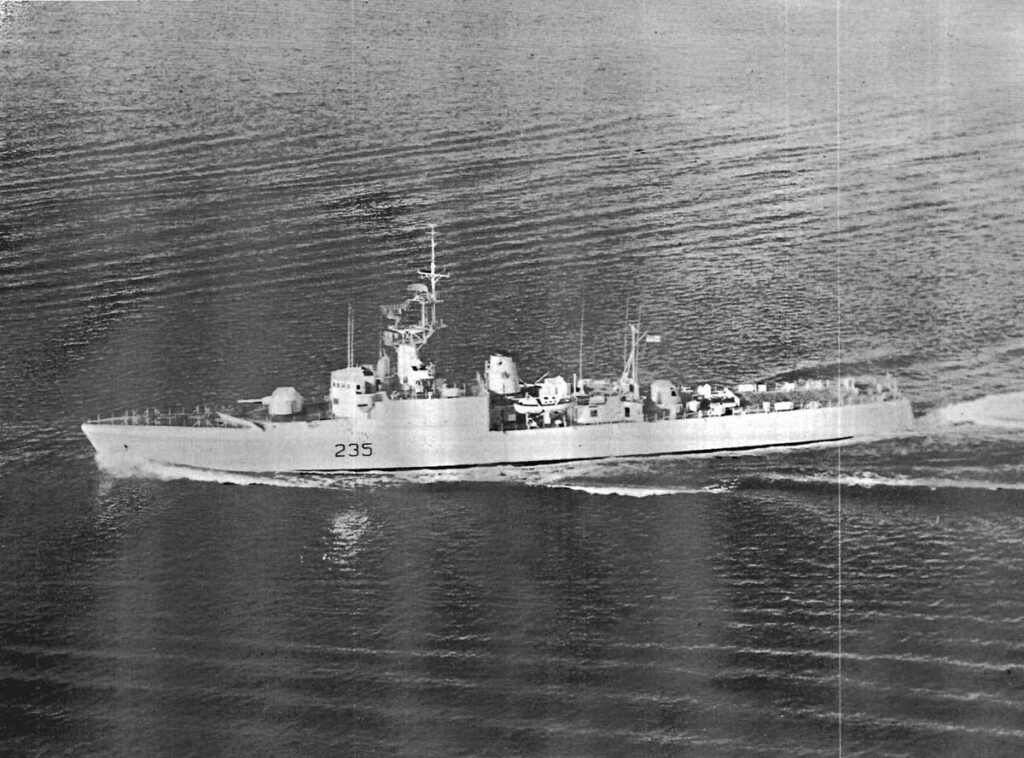From 1959 to 1974, HMCS Chaudière was a Restigouche-class destroyer and the second vessel of her class in the Royal Canadian Navy and later the Canadian Forces. She was the second naval unit in Canada to bear this name. During the summer of 1974, she and her sister ship, HMCS Columbia, were docked at the DND jetty in Colwood and served as the base of operations for the Esquimalt Sea Cadet Camp. This location was across the harbour from CFB Esquimalt’s main base.
The Restigouches had the same hull and propulsion as the preceding St. Laurent-class design, but different weaponry. Originally, 14 ships were planned for the St. Laurent class. The order was halved, and the next seven were redesigned to incorporate St. Laurents improvements. Their design gradually diverged from that of the St. Laurents.
The ships had a displacement of 2,000 tonnes (2,000 long tons) at full load and 2,500 tonnes (2,500 long tons) at deep load. They were intended to be 112 meters (366 feet) long, with a beam of 13 meters (42 feet) and a draught of 4.01 meters (13 feet 2 inches). The Restigouches had a crew of 214 people.
The Restigouches were propelled by two English Electric geared steam turbines, each driving a propeller shaft and fed by steam from two Babcock & Wilcox boilers. They produced 22,000 kilowatts (30,000 shp), allowing the vessels to reach a top speed of 28 knots (52 km/h; 32 mph).
The Restigouches had SPS-10, SPS-12, Sperry Mk 2 and SPG-48 radar, as well as SQS-501 and SQS-503 sonar.
Halifax Shipyards in Halifax, Nova Scotia laid down Chaudière on July 30, 1953. She was the last of her class and was named after a river in Quebec. The ship debuted on November 13, 1957. In September 1958, the escort was damaged by a fire that cost $200,000 in damage. A visiting engineer died after falling on October 4, 1958. The ship was commissioned as DDE 235 on November 14, 1959, in Halifax. The ceremony’s honoree was Prime Minister John Diefenbaker.
Following the unification of the Canadian Armed Forces and the transition from the Royal Canadian Navy to Maritime Command, Chaudière was assigned to the Second Canadian Escort Squadron on the west coast.[11] She left Halifax for Esquimalt on October 2, 1967.[4]
Originally, all seven Restigouche-class ships were to be upgraded to the IRE refit, but due to financial constraints, Chaudière’s conversion was cut, and the ship was reduced to a training ship by 1970. Chaudière was paid off and used as a source for parts for the rest of the class on May 23, 1974.
Chaudière’s sister ship, the Kootenay, collided with a merchant vessel in 1989, severely damaging her bow. To repair the damage, Kootenay’s bow was removed and Chaudière’s bow was installed.
The former destroyer escort was sold to the Artificial Reef Society of British Columbia for $1 in September 1991 for use as an artificial reef. After government funding was cut, the project to use the ship was largely saved by community donations. On December 5, 1992, the ship sank in Sechelt Inlet, British Columbia.







